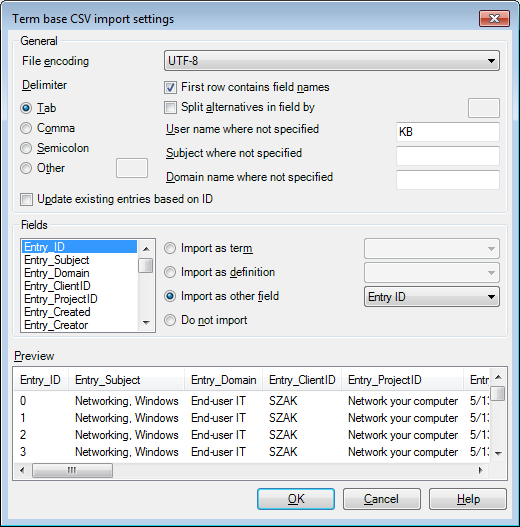|
memoQ can import tabular text files – tab-separated, CSV or Excel files – into term bases. In the Resource console, choose a term base to import the Excel file contents into, click the Import terminology link, and then browse for a CSV, Excel or a tab-separated file to import. memoQ will attempt to set the options automatically. However, you might need to check the preview before proceeding with the import. If it does not appear correctly, you need to change the settings manually.
How to beginNavigate to the Term bases pane of the Resource console. Or, in an open project, click the Term bases icon in Project home. In both cases, a list of term bases appears. You will also see a list of term bases in the fourth page of the New memoQ project wizard. Select the term base you want to import the CSV file into, click the Import terminology link, then, in the Open dialog, locate and select the CSV file to import. StructureThe Term base CSV import settings dialog consists of the following sections: •General: Specifies the file encoding, the delimiter character, whether or not the field names are written into the first row of the CSV file, and other general properties. •Fields: Assigns fields in the CSV file to fields of a term base entry •Preview: Displays how the first 256 lines of the CSV file would be imported as per the present settings, and a series of buttons. UseGeneral section: •File encoding: Use this drop-down list to select the encoding of the CSV file. CSV is a text file, and therefore encoding information is not stored in it. •First row contains field names: Check this check box if the first row of the CSV file contains the names of the fields. Uncheck it if the first row already contains data to be imported. If you uncheck it, the field names in the Preview section will be F1, F2, F3 and so on. •Delimiter: oTab: Select this radio button to use tab as delimiter that separates one column from the other in the CSV file. oComma: Select this radio button to use comma as delimiter that separates one column from the other in the CSV file. oSemicolon: Select this radio button to use semicolon as delimiter that separates one column from the other in the CSV file. oOther: Select this radio button to use a custom character as delimiter that separates one column from the other in the CSV file. •Split alternatives in field by: Check this check box to specify the delimiter that separates one entry in the same column from another. If memoQ finds the same column name twice, it will automatically import the two entries as alternatives. •User name where not specified: Use this field to enter a value that will be automatically attributed to the terms if there is no such column specified, or the corresponding field is empty. •Subject where not specified: Use this field to enter a value that will be automatically attributed to the terms if there is no such column specified, or the corresponding field is empty. •Domain name where not specified: Use this field to enter a value that will be automatically attributed to the terms if there is no such column specified, or the corresponding field is empty. •Update existing entries based on ID: Check this check box to update existing entries with the CSV file entries having the same ID. Fields section: For each field, you can select how it should be imported. A field is a column in the table. The Fields section allows you to assign or not assign fields in a CSV file to fields of a term base entry. •Fields list: Go through every field name listed, and select how they should be imported. All changes in the controls to the right apply to the field that is currently selected in this list. •Import as term: Select this radio button to import the contents of the selected field as terms in the language you specify. •Import as definition: Select this radio button to import the contents of the selected field as definitions in the language you specify. •Import as other field: Select this radio button to import the contents of the selected field as Subject, Domain, Note, Creation Date, Creator, Last Modification Date or Last Modified By. •Do not import: Select this radio button if you do not want to import the contents of the selected field. Note: If you do want to import fields, verify that you have not the Do not import option selected for a field. To exclude fields for import, choose the Do not import option. The specified field will not be imported in your term base. Preview section: While you are configuring the import, look at the preview that shows you how the first 256 lines of the CSV file will be imported. Pay special attention to the correct display of special characters.
Fuzzy matching from memoQ 6.2 and higher term bases When you import a memoQ term base from memoQ 6.2 into a memoQ 2013 or higher term base, the matching settings will be the following: memoQ 6.2 memoQ 2013 / memoQ 2013 R2 / memoQ 2014 / memoQ 2014 R2 Yes Fuzzy No Exact Custom Custom 50% minimum 50% prefix After you imported the CSV into memoQ 2013 or higher, and you add a new term to the term base, this term will then have the new term defaults. NavigationTo start importing the CSV file into the current term base, click OK. If the term base does not contain any of the languages that the CSV file contains, you will be prompted if you want to add the language to the term base or ignore importing entries in the new languages. After clicking OK, memoQ displays the results of the import. Click Cancel to leave the dialog without importing the CSV file.
See also: |
